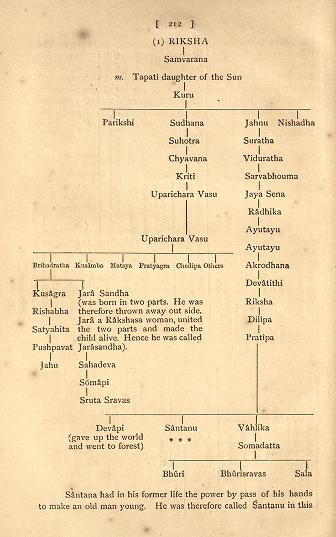
| JARASANDH Jarasandh was a great and powerful Chandravanshi king of Magadh. He was the son of a vedic king named Brihadrath. He was also a great devotee of Lord Shiv. He enmity with the Yadav clan in the Mahabharat. There is a famous Jarasandh's Akhara at Rajgir where martial arts were practiced by Jarasandh.
Modern
descendant of Jarasandh :
Ancestry of Jarasandh as per Bhagavat Puran According to James Todd Kuru had two sons, Sudhanush and Parikshita. The descendants of the former terminated with Jarasandh, whose capital was Rajagriha on the Ganges, in the province of Bihar. Rajgir is in Patna District.
Ancestry of Jarasandh as per Bhagavat Puran is as under :
Samvarana (+Tapati) → Kuru → Sudhana → Suhotra → Chyavan → Kriti ? Uparichara Vasu → Vrihadrath → Jarasandh ? Sahdev → Somapi → Sruta Sravas
James Todd writes that Jarasandh was the monarch of Rajagriha,3 or Bihar, whose son Sahadeva, and grandson Marjari, are declared to have been contemporaries of the Mahabharat, and consequently coeval with Parikshita, the Delhi sovereign.
The direct line of Jarasandh terminates in twenty-three descents with Ripunjaya, who was slain, and his throne assumed by his minister, Sanaka, whose dynasty terminated in the fifth generation with Nandivardandhana. Sanaka derived no personal advantage from his usurpation, as he immediately placed his son, Pradyota, on the throne. To these five princes one hundred and thirty-eight years are assigned.
History
:
Birth
of Jarasandh :
Chandakaushika arrived at the court and saw the child. He prophesied to Brihadrath that his son will be specially gifted and would be a great devotee of Lord Shiv.
Life
of Jarasandh :
When Krishna killed Kansa in Mathura, Jarasandh become enraged because of Krishna and the entire Yadavas clan on seeing his two daughters being widowed. So, Jarasandh attacked Mathura repeatedly. He attacked Mathura 17 times with an army bigger than the last. But he was defeated by Krishna and Balaram every single time. Sensing danger over the repeated attack on Mathura by Jarasandh, Krishna relocated his capital city to Dwaraka. Dwaraka was an island and it was not possible for anyone to attack it at all. Hence, Jarasandh could not attack the Yadavas anymore.
Tribes
fled out of fear of Jarasandh :
Kshatriyas in support of Jarasandh: Jarasandh, enjoying the sovereignty over the middle portion of the earth (Mathura), resolved to create a disunion amongst Kings. Sisupala, placed himself under his protection and became the generalissimo of his forces. Vaka, the king of the Karushas, Hansa and Dimvaka, Dantavakra, Karusha, Karava, Meghavahana, Yavanas, Muru and Naraka, Varuna, who is called Bhagadatta, Purujit, Chedis, Vanga, Pundra, Paundraka, Vasudeva espoused the side of Jarasandh.
List Tribes fled out of fear of Jarasandh - Surasenas, Bhadrakas, Vodhas, Salwas, Patachcharas, Susthalas, Mukuttas, Kulindas, Kuntis, Salwayana, Panchalas, Kosalas , [Matsya]]s, Sannyastapadas.
Death
:
Thus, Krishna advised Yudhisthira that Jarasandh must be killed before Yudhisthira starts performing the Rajasuya yagna. Krishna further stated that it was not possible for Yudhisthira to defeat Jarasandh in a war as he had a boon of not being killed through any weapons. To find a way out, Krishna suggested to wage a Mallayudda (one on one battle / wrestling) with Jarasandh. So, Krishna, Bhima and Arjuna disguised as Brahmins and went to the capital of Jarasandh.
Like Karna, Jarasandh was also very good in giving charity donations. After performing his Shiva pooja, he used to give whatever the Brahmins asked for. On one such occasion Krishna, Arjuna and Bheema in the guise of Brahmins met Jarasandh. Krishna asked Jarasandh to choose any one of them for a Mallayudda. Jarasandh choose Bheema to wrestle. Both of them fought for 27 days. Bheema did not know how to defeat Jarasandh. So, he sought the help of Krishna. Krishna knew the secret by which Jarasandh could be killed. Since, Jarasandh was brought to life when the two lifeless halves joined together, conversely, he can be killed only when these his body was torn into two halves and find a way as how these two don't merge.
Krishna took a stick, he broke it into two and threw them in both directions. Bheema got the hint. He tore Jarasandh's body into two and threw the pieces in two directions. But, these two pieces came together and Jarasandh was able to battle Bheema again. Bheema got tired after several such futile attempts. He again sought the help of Krishna. This time, Lord Krishna took a stick, broke it into two and threw the left piece on right side and the right piece on the left side. Bheema followed precisely the same. Now, he tore Jarasandh's body into two and threw them in opposite directions. Thus, Jarasandh was killed as the two pieces could not merge into one.
After his death, the Pandavas released all the 95 kings who were imprisoned by Jarasandh and made the Son of Jarasandh (Sahdeva) as the king of Magadha. Thus, these 95 kings along with the Sahdeva ruler of Magadha became an ally of Pandavas who took part in the great Mahabharat war later.
Other Dwandwa yuddhas :
A Dwandwa yudda refers to a one on one battle between two great warriors. This does not involve the destruction of an entire army. The Mallayudda (wrestling) between Bheema and Jarasandh lasts 27 days. Similarly, the dwandayuddha between Parasurama and Bhishma lasts for 30 days, while that between Krishna and Jambavan lasts for 28 days. Likewise, the Dwandwa Yudda between king Vaali (Sugreeva's brother) and a demon in the form of a Buffalow lasts for 45 days. Thus in those days, many of the Dwandwa yuddas fought between two great warriors lasted for more than a month. It was only after a month long battle, the battle concluded by some unique strategies adapted by one warrior in order to gain an upperhand over his opponent.
Pippalguha
:
Source
: |
